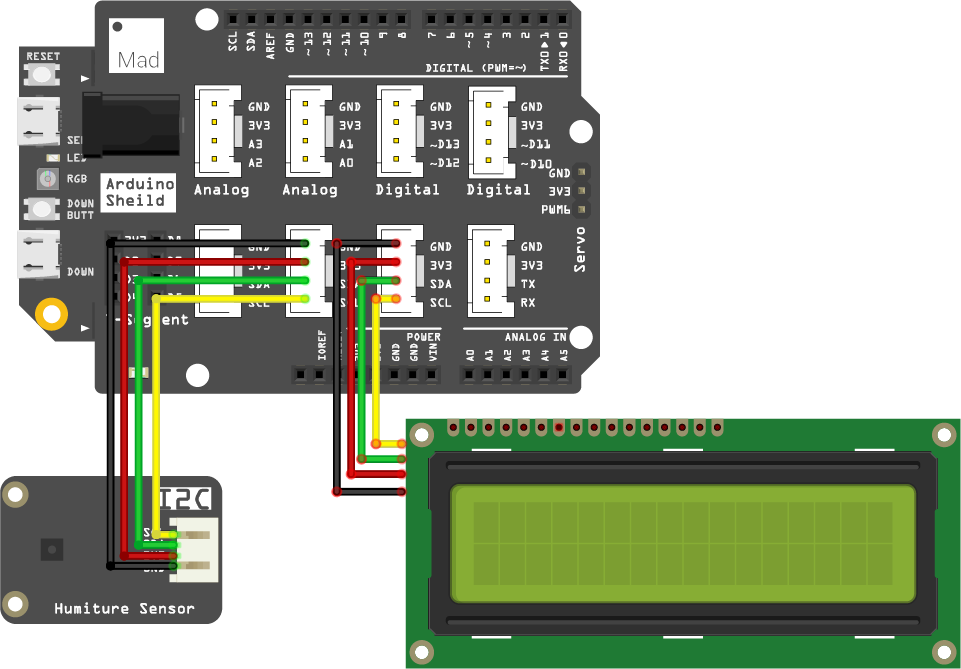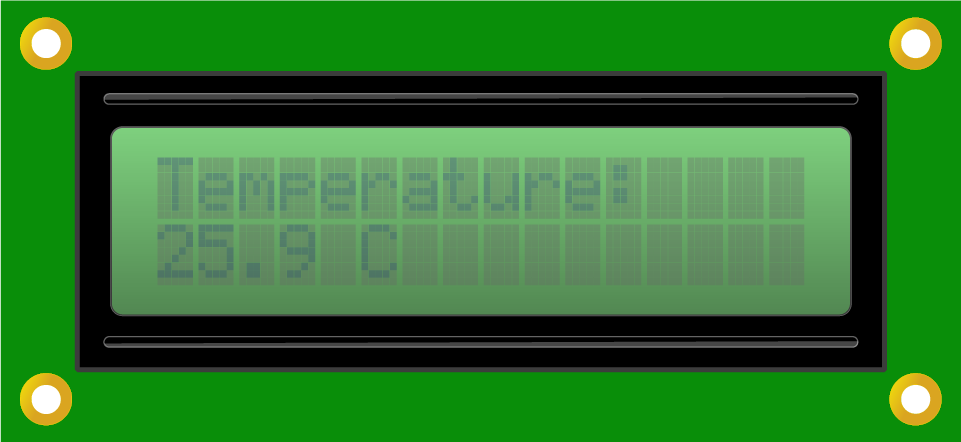Mission10_Humiture_Sensor
In the previous mission, you learn about the LCD. Now you're going to use it to show the current temperature in your room. So you will need a temperature sensor to measure the value.
What you need
The parts you will use are all included in the Maker kit.
- SwiftIO board
- Shield
- Humiture sensor
- 16x2 LCD
- 4-pin cable
Circuit
- Plug the shield on top of the SwiftIO board.
- Connect the humiture sensor and the LCD to I2C0. There are three available pins, you could choose any two.

Example code
Open the project Mission10_Humiture_Sensor in the folder MadExamples/Examples/MakerKit if you downloaded the folder.
- Mission10_Humiture_Sensor.swift
- SHT3x.swift
- LCD1602.swift
import SwiftIO
import MadBoard
@main
public struct Mission10_Humiture_Sensor {
public static func main() {
// Initialize the LCD and sensor to use the I2C communication.
let i2c = I2C(Id.I2C0)
let lcd = LCD1602(i2c)
let sht = SHT3x(i2c)
while true{
// Read and display the temperature on the LCD and update the value every 1s.
let temp = sht.readCelsius()
lcd.write(x:0, y:0, "Temperature:")
lcd.write(x: 0, y: 1, temp)
lcd.write(x:4, y:1, " ")
lcd.write(x:5, y:1, "C")
sleep(ms: 1000)
}
}
}
import SwiftIO
final public class SHT3x {
let i2c: I2C
let address: UInt8
private var readBuffer = [UInt8](repeating: 0, count: 6)
public init(_ i2c: I2C, address: UInt8 = 0x44) {
self.i2c = i2c
self.address = address
reset()
}
public func reset() {
sleep(ms: 2)
try? writeCommand(.softReset)
sleep(ms: 2)
}
public func readCelsius() -> Float {
try? readRawValue(into: &readBuffer)
let rawTemp = UInt16(readBuffer[0]) << 8 | UInt16(readBuffer[1])
return 175.0 * Float(rawTemp) / 65535.0 - 45.0
}
public func readFahrenheit() -> Float {
try? readRawValue(into: &readBuffer)
let rawTemp = UInt16(readBuffer[0]) << 8 | UInt16(readBuffer[1])
return 315.0 * Float(rawTemp) / 65535.0 - 49.0
}
public func readHumidity() -> Float {
try? readRawValue(into: &readBuffer)
let rawHumi = UInt16(readBuffer[3]) << 8 | UInt16(readBuffer[4])
return 100.0 * Float(rawHumi) / 65535.0
}
}
extension SHT3x {
private enum Command: UInt16 {
case readStatus = 0xF32D
case clearStatus = 0x3041
case softReset = 0x30A2
case heaterEnable = 0x306D
case heaterDisable = 0x3066
case measureHigh = 0x2400
case measureMedium = 0x240B
case measureLow = 0x2416
case measureStretchHigh = 0x2C06
case measureStretchMedium = 0x2C0D
case measureStretchLow = 0x2C10
}
private func writeCommand(_ command: Command) throws {
let value = command.rawValue
let result = i2c.write([UInt8(value >> 8), UInt8(value & 0xFF)], to: address)
if case .failure(let err) = result {
throw err
}
}
private func readRawValue(into buffer: inout [UInt8]) throws {
for i in 0..<buffer.count {
buffer[i] = 0
}
try? writeCommand(.measureMedium)
sleep(ms: 8)
let result = i2c.read(into: &buffer, from: address)
if case .failure(let err) = result {
throw err
}
}
}
import SwiftIO
final public class LCD1602 {
private enum Command: UInt8 {
case clearDisplay = 0x01
case returnHome = 0x02
case entryModeSet = 0x04
case displayControl = 0x08
case cursorShift = 0x10
case functionSet = 0x20
case setCGRAMAddr = 0x40
case setDDRAMAddr = 0x80
}
private struct FunctionMode: OptionSet {
let rawValue: UInt8
static let _4BitMode = FunctionMode([])
static let _8BitMode = FunctionMode(rawValue: 0x10)
static let _1Line = FunctionMode([])
static let _2Line = FunctionMode(rawValue: 0x08)
static let _5x8Dots = FunctionMode([])
static let _5x10Dots = FunctionMode(rawValue: 0x04)
}
private struct ControlMode: OptionSet {
let rawValue: UInt8
static let displayOff = ControlMode([])
static let displayOn = ControlMode(rawValue: 0x04)
static let cursorOff = ControlMode([])
static let cursorOn = ControlMode(rawValue: 0x02)
static let blinkOff = ControlMode([])
static let blinkOn = ControlMode(rawValue: 0x01)
}
private struct EntryMode: OptionSet {
let rawValue: UInt8
static let entryRight = EntryMode([])
static let entryLeft = EntryMode(rawValue: 0x02)
static let entryShiftDecrement = EntryMode([])
static let entryShiftIncrement = EntryMode(rawValue: 0x01)
}
private struct ShiftMode: OptionSet {
let rawValue: UInt8
static let cursorMove = ShiftMode([])
static let displayMove = ShiftMode(rawValue: 0x08)
static let moveLeft = ShiftMode([])
static let moveRight = ShiftMode(rawValue: 0x04)
}
let i2c: I2C
let address: UInt8
private var funntionModeConfig: FunctionMode
private var controlModeConfig: ControlMode
private var entryModeConfig: EntryMode
private var shiftModeConfig: ShiftMode
public init(_ i2c: I2C, address: UInt8 = 0x3E,
columns: UInt8 = 16, rows: UInt8 = 2, dotSize: UInt8 = 8) {
guard (columns > 0) && (rows == 1 || rows == 2)
&& (dotSize == 8 || dotSize == 10) else {
fatalError("LCD1602 parameter error, init failed")
}
self.i2c = i2c
self.address = address
funntionModeConfig = FunctionMode([])
controlModeConfig = ControlMode([.displayOn, .cursorOff, .blinkOff])
entryModeConfig = EntryMode([.entryLeft, .entryShiftDecrement])
shiftModeConfig = ShiftMode([])
if rows > 1 {
funntionModeConfig.insert(._2Line)
}
if dotSize != 8 && rows == 1 {
funntionModeConfig.insert(._5x10Dots)
}
writeConfig(funntionModeConfig, to: .functionSet)
sleep(ms: 5)
writeConfig(funntionModeConfig, to: .functionSet)
sleep(ms: 1)
writeConfig(funntionModeConfig, to: .functionSet)
writeConfig(funntionModeConfig, to: .functionSet)
leftToRight()
noAutoScroll()
clear()
turnOn()
}
public func clear() {
writeCommand(.clearDisplay)
sleep(ms: 2)
}
public func home() {
writeCommand(.returnHome)
sleep(ms: 2)
}
public func turnOn() {
controlModeConfig.insert(.displayOn)
controlModeConfig.remove(.displayOff)
writeConfig(controlModeConfig, to: .displayControl)
}
public func turnOff() {
controlModeConfig.insert(.displayOff)
controlModeConfig.remove(.displayOn)
writeConfig(controlModeConfig, to: .displayControl)
}
public func cursorOn() {
controlModeConfig.insert(.cursorOn)
controlModeConfig.remove(.cursorOff)
writeConfig(controlModeConfig, to: .displayControl)
}
public func cursorOff() {
controlModeConfig.insert(.cursorOff)
controlModeConfig.remove(.cursorOn)
writeConfig(controlModeConfig, to: .displayControl)
}
public func cursorBlinkOn() {
controlModeConfig.insert(.blinkOn)
controlModeConfig.remove(.blinkOff)
writeConfig(controlModeConfig, to: .displayControl)
}
public func cursorBlinkOff() {
controlModeConfig.insert(.blinkOff)
controlModeConfig.remove(.blinkOn)
writeConfig(controlModeConfig, to: .displayControl)
}
public func leftToRight() {
entryModeConfig.insert(.entryLeft)
entryModeConfig.remove(.entryRight)
writeConfig(entryModeConfig, to: .entryModeSet)
}
public func rightToLeft() {
entryModeConfig.insert(.entryRight)
entryModeConfig.remove(.entryLeft)
writeConfig(entryModeConfig, to: .entryModeSet)
}
public func autoScroll() {
entryModeConfig.insert(.entryShiftIncrement)
entryModeConfig.remove(.entryShiftDecrement)
writeConfig(entryModeConfig, to: .entryModeSet)
}
public func noAutoScroll() {
entryModeConfig.insert(.entryShiftDecrement)
entryModeConfig.remove(.entryShiftIncrement)
writeConfig(entryModeConfig, to: .entryModeSet)
}
public func scrollLeft() {
shiftModeConfig.insert([.displayMove, .moveLeft])
shiftModeConfig.remove([.cursorMove, .moveRight])
writeConfig(shiftModeConfig, to: .cursorShift)
}
public func scrollRight() {
shiftModeConfig.insert([.displayMove, .moveRight])
shiftModeConfig.remove([.cursorMove, .moveLeft])
writeConfig(shiftModeConfig, to: .cursorShift)
}
public func clear(x: Int, y: Int, count: Int = 1) {
guard count > 0 else {
return
}
let data: [UInt8] = [0x40, 0x20]
setCursor(x: x, y: y)
for _ in 1...count {
i2c.write(data, to: address)
}
setCursor(x: x, y: y)
}
public func setCursor(x: Int, y: Int) {
guard x >= 0 && y >= 0 else {
return
}
let val: UInt8 = y == 0 ? UInt8(x) | 0x80 : UInt8(x) | 0xc0
writeCommand(val)
}
public func write(x: Int, y: Int, _ str: String) {
setCursor(x: x, y: y)
writeData(str)
}
public func write(x: Int, y: Int, _ num: Int) {
write(x: x, y: y, String(num))
}
public func write(x: Int, y: Int, _ num: Float, decimal: Int? = 1) {
if let decimal = decimal {
if decimal <= 0 {
write(x: x, y: y, String(Int(num)))
return
}
var mul = 1
for _ in 0..<decimal {
mul *= 10
}
let expandValue = Int(num * Float(mul))
write(x: x, y: y, String(Float(expandValue) / Float(mul)))
} else {
write(x: x, y: y, String(num))
}
}
}
extension LCD1602 {
private func writeCommand(_ command: Command) {
writeCommand(command.rawValue)
}
private func writeCommand(_ value: UInt8) {
let data: [UInt8] = [0x80, value]
i2c.write(data, to: address)
}
private func writeConfig<T: OptionSet>(_ config: T, to command: Command) {
let value = config.rawValue as? UInt8
guard value != nil else {
return
}
writeCommand(value! | command.rawValue)
}
private func writeData(_ str: String) {
let bytes: [UInt8] = Array(str.utf8)
var data: [UInt8] = [0x40, 0]
for byte in bytes {
data[1] = byte
i2c.write(data, to: address)
}
}
}
Background
Humiture sensor
The humiture sensor can sense the temperature and humidity at the same time. This one uses the I2C protocol to communicate with the SwiftIO board. You can find a file SHT3x.swift in example code to read the values.
Code analysis
In this project, there is the file LCD1602.swift for the LCD and the file SHT3x.swift for the sensor. You can directly use them to simplify your code and don't need to configure them according to their datasheet.
So let's come to the file Mission10_Humiture_Sensor.swift.
import SwiftIO
import MadBoard
Import the two libraries: SwiftIO and MadBoard. SwiftIO is used to control the input and output of all boards. MadBoard defines the pin name of the board.
let i2c = I2C(Id.I2C0)
let lcd = LCD1602(i2c)
let sht = SHT3x(i2c)
Initialize the I2C interface I2C0. Then initialize the LCD and the sensor. Both of them need the I2C interface as their parameter.
let temp = sht.readCelsius()
To get the temperature, you need the method readCelsius() in the file SHT3x.swift. It will calculate the temperature into Celsius.
lcd.write(x:0, y:0, "Temperature:")
lcd.write(x: 0, y: 1, temp)
lcd.write(x:4, y:1, " ")
lcd.write(x:5, y:1, "C")
As you get the value, you can display it on the LCD. The four statements are all about the content to be displayed:
- The first row of the LCD will display the text "Temperature:". It starts from the origin.
- The temperature displays on the second row from the first column. They will take up four characters.
- The fifth is blank to separate the value from the unit.
- The sixth is the unit.

sleep(ms: 1000)
The sensor will read value every 1s, so the value on the LCD will refresh per second.
Reference
I2C - use the I2C protocol to communicate with other devices.
MadBoard - find the corresponding pin ids of your board.